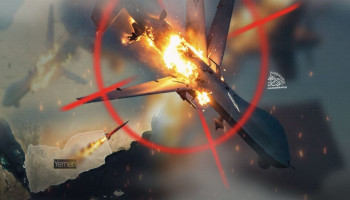The American newspaper "The Cradle" reported that an unprecedented Yemeni drone strike on Israel's economic power center has shattered the occupation state’s perceived invulnerability.
On July 19, a low-altitude drone penetrated the airspace over Tel Aviv from the sea and exploded, killing one person and injuring ten others, according to "26 September Net."
The incident has caused a wave of shock in Israel, with residents panicking and confusion reigning among decision-makers grappling with the "colossal failure" of the Israeli military to intercept a single drone amidst prolonged aggression against Gaza and escalating tensions with Hezbollah in Lebanon. The impact of the attack was magnified due to its direct hit on Tel Aviv, the heart of Israel's governmental and economic power, starkly exposing the deficiencies in its defense strategies and further unsettling a populace that has been questioning the effectiveness of military preparations for months.
The use of suicide drones, a relatively modern weapon, poses significant challenges even for technologically advanced nations like the United States and Israel. These drones vary in range, warhead size, speed, and guidance methods.
Debris analysis revealed that a "Yafa" drone, an upgraded version of Yemen's "Samad" drones, was used in the operation. The name carries symbolic weight, referring to the ancient coastal city of Jaffa, known in Arabic as Yafa, now part of modern Tel Aviv.
The drone is distinguished by its rectangular wing shape and V-tail design, but notably, it features a more powerful 275 cc "16 kW" engine. This engine enables the drone to cover distances exceeding 2,000 kilometers—sufficient to reach Tel Aviv from Yemen. Unlike ballistic missiles, the challenge in tracking drones lies in their ability to follow unconventional paths, maneuver through winding routes, and hide behind terrain features, making them difficult to detect by radar systems.
Consequently, radar systems can mistake drones for birds. This confusion has been a regular occurrence in northern occupied Palestine since the beginning of the war, with Israel's Iron Dome defense system expending its limited $50,000 interceptors on birds during the conflict.
The suicide drone likely followed an unconventional route to evade detection.
On July 20, Israeli aircraft launched airstrikes on the besieged Yemeni port of Hodeidah, specifically targeting areas designated for fuel and oil storage, as well as destroying cranes used for loading and unloading goods and a power station. However, these were civilian targets in a country already suffering from the effects of a Saudi-led coalition blockade, which has caused severe shortages of fuel and essential resources needed for power generation and transportation.
The Israeli response to civilian targets also reveals Tel Aviv's lack of intelligence on potential Yemeni military targets. It is also apparent that the chosen targets were those that Saudi Arabia and the United States had refrained from striking due to fears of Yemeni retaliation, which could hit Saudi commercial ports or oil exports in one of the world's most vital energy passages.
In fact, Riyadh was quick to deny any involvement in the attack, fearing retaliation from Sanaa, despite reports that Israeli aircraft used Saudi airspace to launch this attack.
Read More:
https://thecradle.co/articles-id/26089







